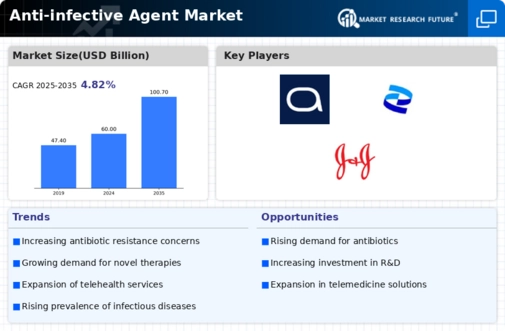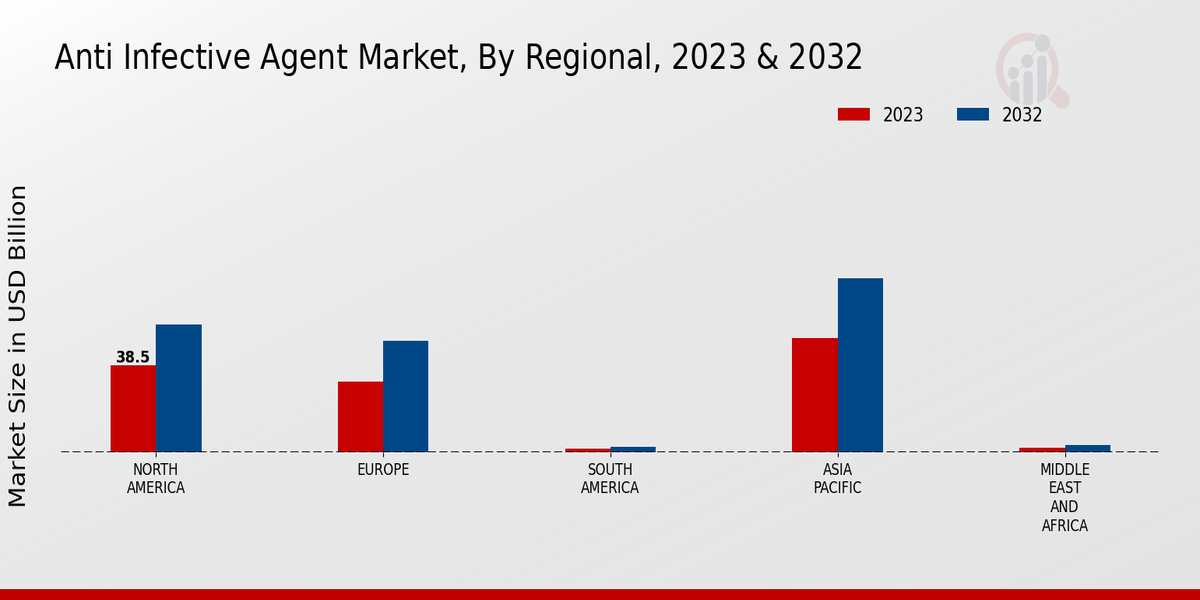Market Growth Projections
The Global Anti-infective Agent Market Industry is projected to experience substantial growth, with forecasts indicating a market size of 60.0 USD Billion in 2024 and an increase to 100.7 USD Billion by 2035. This growth trajectory suggests a compound annual growth rate (CAGR) of 4.82% from 2025 to 2035, reflecting the increasing demand for anti-infective agents driven by various factors, including rising infectious disease prevalence and advancements in pharmaceutical research. The market's expansion is likely to be influenced by ongoing innovations and regulatory support, positioning it as a critical sector within the global healthcare landscape.
Increasing Healthcare Expenditure
The Global Anti-infective Agent Market Industry benefits from rising healthcare expenditures across various regions. Governments and private sectors are allocating more resources to healthcare, which includes funding for anti-infective treatments. This trend is particularly evident in developing nations, where healthcare budgets are expanding to combat infectious diseases. As a result, the demand for anti-infective agents is likely to increase, supporting market growth. The anticipated compound annual growth rate (CAGR) of 4.82% from 2025 to 2035 underscores the potential for sustained investment in healthcare infrastructure and pharmaceutical advancements.
Advancements in Pharmaceutical Research
Innovations in pharmaceutical research are pivotal to the Global Anti-infective Agent Market Industry. The continuous evolution of drug discovery technologies, including genomics and bioinformatics, enhances the development of new anti-infective agents. This progress is evidenced by the introduction of novel antibiotics and antiviral medications that target resistant strains of pathogens. As the market anticipates a growth trajectory towards 2035, projected to reach 100.7 USD Billion, the emphasis on research and development is likely to intensify. Regulatory bodies are also fostering an environment conducive to innovation, which may further stimulate the market.
Rising Incidence of Infectious Diseases
The Global Anti-infective Agent Market Industry is driven by the increasing prevalence of infectious diseases worldwide. In 2024, the market is projected to reach 60.0 USD Billion, reflecting a growing demand for effective anti-infective treatments. Factors such as urbanization, globalization, and climate change contribute to the spread of infectious pathogens. For instance, the World Health Organization indicates that infectious diseases account for a significant portion of global morbidity and mortality. This trend necessitates the development and distribution of anti-infective agents, thereby propelling market growth and innovation in therapeutic solutions.
Regulatory Support for New Drug Approvals
Regulatory bodies play a crucial role in shaping the Global Anti-infective Agent Market Industry by facilitating the approval of new anti-infective agents. Streamlined approval processes and incentives for antibiotic development are increasingly evident, as governments recognize the urgency of addressing infectious diseases. This regulatory support is likely to encourage pharmaceutical companies to invest in research and development, resulting in a more robust pipeline of anti-infective agents. As the market evolves, the collaboration between regulatory agencies and the pharmaceutical industry may enhance the availability of effective treatments, thereby contributing to market expansion.
Growing Awareness of Antimicrobial Resistance
The Global Anti-infective Agent Market Industry is increasingly influenced by the growing awareness of antimicrobial resistance (AMR). As healthcare professionals and the public become more cognizant of the implications of AMR, there is a heightened demand for effective anti-infective therapies. Initiatives by global health organizations aim to educate stakeholders about the responsible use of antibiotics and the importance of developing new agents. This awareness is likely to drive investments in research and development, ultimately leading to the introduction of innovative solutions that address resistant infections, thereby fostering market growth.














